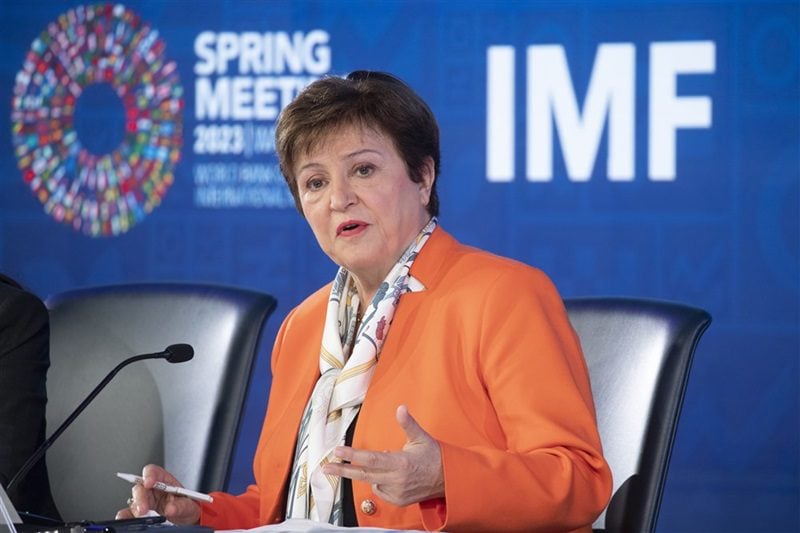
(The Habesha) – In the contemporary world of global finance, IMF loans, like the one extended to Ethiopia, often pose critical questions about economic stability, sustainability and the future of developing nations. As these credits frequently contribute more to increasing national debts rather than reducing them, their viability in bolstering economies is increasingly debated. Ethiopia’s recent $3.4 billion loan serves as a pertinent case study, raising concerns due to the nation’s current high debt levels, potential for economic instability, and questionable allocations toward military expenditures. Similar situations can be observed in other nations like Pakistan, Somalia, and Argentina, where IMF lending practices reflect a certain pragmatic perspective rather than a sense of moral duty. This introduction explores the complex dynamics of IMF loans to developing nations, the intricate interplay of risks and benefits, illuminating a phenomenon that has far-reaching implications for not just Ethiopia, but the global economy as a whole.
The International Monetary Fund (IMF) is an international organization aimed at promoting global monetary cooperation, securing financial stability, and fostering sustainable economic growth. It often provides loans to nations facing economic difficulties, with the goal of restoring global financial stability. However, the impact these loans have on recipient nations is a subject of considerable controversy. One such example is the current IMF loan to Ethiopia, which has stirred debate due to its perceived hazardous impacts on not just Ethiopia, but future generations as well.
Ethiopia is dealing with a protracted internal conflict, which has devastated the economy and escalated humanitarian needs. To aid in this crisis, the IMF extended a loan of $3.4 billion. But critics argue that the loan may lead to an increase in the nation’s already high level of debt, which would adversely affect future generations.
The IMF approved the extended arrangement under the Extended Fund Facility (EFF) for Ethiopia in the amount of SDR 2.26 billion (about US$3.4 billion, 179 percent of quota) in January 2023 to support the country’s reform program. The overall aim is to help Ethiopia return to a stable growth path, strengthen its repayment capacity, and foster sustainable and inclusive growth. An initial disbursement of SDR 325.35 million (about US$487.5 million) was made available right after the approval, while the remaining amount will be phased over the program duration, pending semi-annual reviews.
While this loan is expected to provide some measure of relief to Ethiopia’s dire economic situation, it requires strict economic measures, such as spending cuts and revenue increases, which may cause immediate hardship to the populace, particularly those in the lower socio-economic groups. The Ethiopian government has outlined plans to allocate funds from the IMF loan towards areas deemed crucial, including military expenditures for arms and drones.
The loan’s implications extend beyond the immediate need for financial assistance to questions of sovereignty, economic stability, and the future welfare of the Ethiopian population. The immediate implications of the loan appear to serve the present needs of the Ethiopian government more than the long-term welfare and prosperity of its people. To date, there is already an outcry from citizens expressing concerns about the accruement of unsustainable public debt and potential economic instability due to the loan.
The IMF loan to Ethiopia is enveloped with an array of substantial risks that, if not properly mitigated and managed, might lead to severe consequences.
Primarily, there is the possible risk of debt escalation. As it stands, Ethiopia’s public debt stands at approximately 61.2% of its GDP as of 2020. Incorporating the new loan, worth $3.4 billion, into the equation could exacerbate the nation’s economic burden. History has shown that some nations entangled in the cycle of IMF loans often find themselves in a debt trap, where they borrow more to repay their existing debts. If Ethiopia falls into this cycle, debt escalation could become a major concern.
The prospect of an escalating national debt coupled with the existing economic issues already plaguing the country might lead to economic instability. In such a scenario, the country may up with devalued currency, inflation, and ultimately, an economic crisis. Economic instability discourages investments, slows economic growth, and places an unbearable weight on the shoulders of the populace, especially the impoverished.
Finally, IMF loans such as this pose a significant risk for future generations. High levels of national debts mean that future generations of Ethiopians are slated to inherit this debt. The fiscal space of these future governments may be so consumed with debt servicing that they may have limited resources to channel towards important sectors like healthcare, education, and infrastructure. Thus, the burden on future generations arises not only from the obligation to repay the loan but also from the opportunity cost of forgone developments. This potential adversity underscores the vital need for responsible borrowing and effective utilization of the borrowed funds.
In order to gain a comprehensive understanding of the effects of IMF loans, it is necessary to consider instances in other countries. Looking at countries like Pakistan, Argentina, and Somalia can give us significant insights.
Pakistan is one such example where the IMF stepped in to provide a loan, triggered by the belief that a collapsing economy with a population of over 250 million people could negatively impact the global economy. At that time, the cost-benefit analysis favored providing financial assistance to Pakistan, mainly because the fall-out of not doing so could be catastrophic. The IMF’s help also took into account the strategic position of Pakistan on the global political stage. The lessons from Pakistan’s IMF loan experience suggest a complex relationship between the borrowing nations and the IMF, heavily influenced by regional geopolitics, international trade, and security concerns.
As of April 2024, Argentina is the country with the highest debt to the IMF, amounting to a massive $42.9 billion, comprising an alarming 5.3% of its GDP. Over the years, Argentina’s high debt crisis has put its economy in a precarious situation, with rampant inflation, a surge in poverty rates, and fiscal deficit challenges. Argentina’s experience shows that although IMF loans can provide short-term relief, they can result in long-term debts, which may, in turn, lead to a never-ending cycle of borrowing, adversely affecting a nation’s economic health in the long run.
Drawing parallels from Somalia’s scenario, IMF loans can also be regarded as necessary for stabilizing a government, which in turn can improve international trade. For example, the bolstering of Somalia’s government was instrumental in tackling piracy, which was a grave concern to international maritime trade. However, this focus on international trade benefits often overshadows the needs of the natural citizens, contributing to an unbalanced approach to development.
Analyzing the IMF loan scenarios of countries such as Pakistan, Argentina, and Somalia enhances our comprehension of the possible consequences associated with the IMF loan to Ethiopia. This comparison emphasizes the necessity for a meticulous and contextually relevant strategy when engaging with international financial institutions and managing borrowed resources. Failing to adopt such a strategy may jeopardize the economic stability of future generations.+
One critical aspect of understanding the role of the IMF loan in Ethiopia’s economic reality is analyzing the allocation of these borrowed funds. Notably, the directiossssssn of these resources seems to veer away from potentially beneficial sectors such as infrastructure development or social welfare improvements.
Significantly, a large volume of the funds borrowed appear to make their way into military expenditures. Bolstering defense costs with the current IMF loan, the Ethiopian government invests heavily in arms, drones, and other military-grade equipment. The emphasis on military expenditure is unnerving for analysts observing Ethiopia from a humanitarian and economic perspective. Using IMF loans intended for economic stability to fuel conflict does not align with the supposed goals of these funding provisions.
Understanding the concerns springing from the allocation of the loan funds becomes more evident when taken in the context of Ethiopia’s current internal conflicts. The government’s decision to finance the purchase of arms and drones using the IMF loan is not only an economic concern but also exacerbates the ongoing unrest in regions like Amhara and Tigray. With the influx of high-grade military equipment financed by borrowed money, the tensions escalate to alarming levels.
This strategy is not sustainable and ultimately harmful to Ethiopia. Rather than addressing the fundamental structural issues impacting the country’s economy, the excessive allocation of IMF funds to military expenditure directly contributes to the climate of instability, and in the long term, this situation will only serve to perpetuate the cycle of debt that burdens the nation.
The current Prime Minister, Abiy Ahmed, has been instrumental in the escalation of the crisis that has gripped Ethiopia in recent years, particularly in the northern regions of Amhara and Tigray.
In the Amhara and Tigray regions, deep-seated ethnic tensions, political instability, and the constant struggle for power have culminated in protracted conflict. Abiy Ahmed’s government, accused of perpetuating ethnic favoritism, has further inflamed these tensions. Critics argue that the Prime Minister has exploited the situation for political gain, further exacerbating the situation and pushing the country into a devastating humanitarian crisis. The unrest has led to thousands of civilian casualties, displacement of populations, and untold suffering.
The conflict instigated and perpetuated by Abiy Ahmed has resulted in enormous destruction of national infrastructure. Approximately 80% of the infrastructure in the northern areas has reportedly been destroyed. Public utilities such as schools, health centers, and water sanitation systems have been significantly damaged. This has not only disrupted the daily lives of the local populace but also severely impedes the country’s efforts to alleviate poverty and promote sustainable development.
Alarmingly, Abiy Ahmed’s government appears to be strategically misusing the funds received from the IMF loan. There are growing concerns that a significant portion of these funds is being channeled towards military expenditures, particularly for the purchase of arms and drones. This approach has raised concerns among international stakeholders about the ethical aspects of lending and the IMF’s role in inadvertently funding conflict. This misuse of funds not only burdens future generations with unmanageable debt but also fuels the ongoing conflict, leading to further instability and destruction.
In conclusion, the role of Abiy Ahmed in the current crisis is pivotal; his strategies and actions have contributed substantially to the humanitarian disaster unfolding in Ethiopia. The international community needs to heighten its focus on Ethiopia, appraise the implications of the IMF loan, and encourage discourse on sustainable solutions to the crisis.
It’s widely agreed among economists that financial assistance to developing nations has potential to yield mutual benefits. The crux of this assertion lies in various economic theories. The primary one being the theory of comparative advantage: where countries focus on sectors where they hold an advantage, thus increasing overall productivity and economic stability. Moreover, the loan-recipient countries can supplement their inadequate capital, accelerating development projects. However, these assumptions hinge on transparent and responsible management of the loan funds, something recent instances like the IMF loan to Ethiopia have called into question.
The moral and ethical considerations surrounding IMF loans often revolve around the question of whether international monetary institutions hold an obligation to assist financially disadvantaged nations. From a humanitarian perspective, developed nations and international institutions should aid countries struggling economically. However, opponents argue that these loans often lead to increased debt and are used as leverage for political and economic control over these countries.
Ethiopia’s $3.4 billion loan from the IMF has far-reaching effects that extend beyond national borders. Economically speaking, an unstable Ethiopia could destabilize regional markets and risk foreign investments. Politically, the conflict in the regions of Amhara and Tigray further compounds the situation, causing a refugee crisis and potentially inciting regional instability. Understanding the global implications of this loan is key, as it influences discussions surrounding international financial assistance and its role in the future stability of developing nations. As such, the case of Ethiopia poses vital lessons for the international community in assessing the merit and impact of similar loans in future.
.
.
.
#Risks #Implications #Ethiopias #IMF #Loan #Potential #Debt #Crisis #Conflict #Funding #Dilemmas #Habesha #Latest #Ethiopian #News #Insightful #Analysis
Source link











